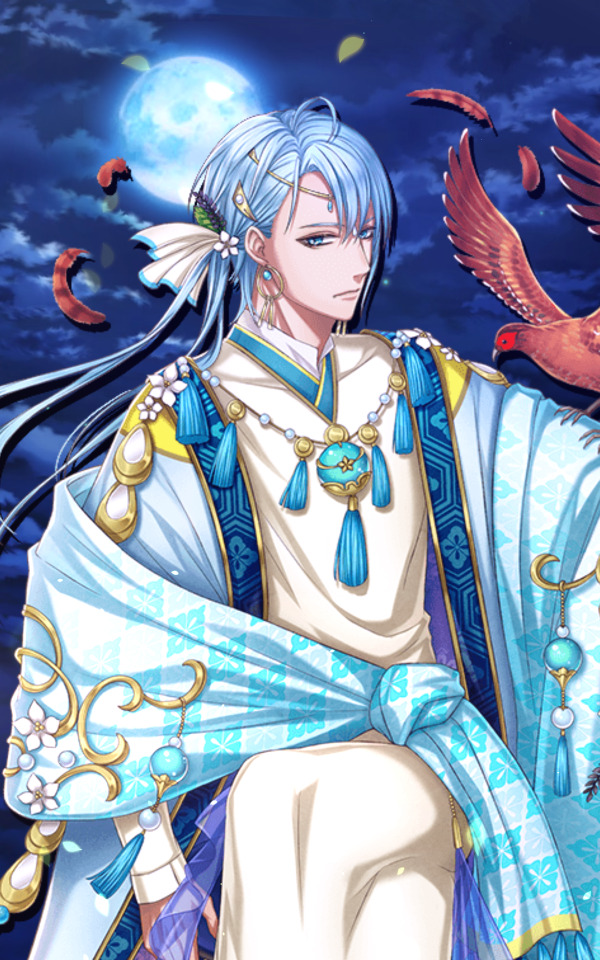#Fujiwara no Teika
Text
Where It All Began: Mount Ogura
Hello everyone,
I just returned from another trip to Japan,1 and we got to spend a bit of time in Kyoto. By accident, I also found Mount Ogura, and the place where Hyakunin Isshu was compiled! But first, let’s backup and explain a bit of history first.
Kyoto was the capital of Japan from the 8th century to the 19th century, and so many well-to-do families lived here. This aristocracy wrote…

View On WordPress
#Fujiwara no Teika#Hyakunin Isshu#Japan#Japanese history#Japanese Poetry#Karuta#Kyoto#Travel#Waka Poetry
4 notes
·
View notes
Text
youtube
鎌倉時代を代表する歌人、藤原定家が古今和歌集についての解釈を書き込んだ注釈書 「顕注密勘」 の自筆の原本が京都で発見され、調査した専門家は国宝級の発見で、定家と古今和歌集の研究が進む重大な資料になるとしています。
1 note
·
View note
Text
HAIKU 俳句
HAIKU – Den Sute-jo (mujer) (1633-1698)-Mañana nevada.-Por todas partes-huellas de zuecos.
HAIKU – Hiroshi Naito (Japón, 1950) -Enamorados del cielo del verano-Los Budas-Se reúnen
HAIKU – Matsue Shigeyoni (Ishu), (Japón, 1596-1670) -En las altas hierbas del verano-Solos avanzan-Los bastones de los peregrinos
HAIKU – TAKAGI HARUKO -Ser un oso -invernando -al fondo de su cueva
HAIKU 1 – FUYUNO…

View On WordPress
#CULTURA ORIENTAL#Den Sute#Den Sute-jo#ESCRITORES JAPONESES#FILOSOFÍA Y PENSAMIENTO JAPONÉS#Fujiwara no Teika#FUYUNO NIJI#HAIKU 俳句#HAIKUS#Hiroshi Naito#HOSHINO TATSUKO#JAPÓN#LITERATURA ORIENTAL#Matsúo Bashó#Matsue Shigeyoni#Matsuo Bashō#NAKAMURA TEIJO#POEMAS CORTOS#POESÍA ORIENTAL#POESIA ORIENTAL#POETA JAPONÉS#POETA JAPONES#poetajaponés#POETAS JAPONESES#SELECCIÓN DE HAIKUS DE MATSUO BASHŌ#SOBRE LOS HAIKUS#SUZUKI MASAJO#TAKAGI HARUKO#Takarai#Yosa Buson
0 notes
Text

定家葛[Teikakazura]
Trachelospermum asiaticum var. asiaticum
定家[Teika] : 藤原 定家[Fujiwara-no Sadaie]
葛[Kazura] : Creeping plant
This one was entangled a large castanopsis tree and producing a lot of flowers in a mountain. A member of the oleander family, it is poisonous. The white flowers have a sweet fragrance.
Its name comes from the part of the Noh Teika where his devotion turned into it and entwined itself around the grave of his beloved 式子 内親王[Shokushi Naishinnō].
By the way, the original reading of 定家 is sadaie, and teika is the on-yomi(Chinese-derived reading) of it. So is reading 式子[Noriko] as shokushi, 俊成[Toshinari] as shunzei, 義経[Yoshitsune] as gikei, 頼光[Yorimitsu] as raikō, 晴明[Haruaki(-ra)|Hareakira] as seimei etc.
https://en.wikipedia.org/wiki/Fujiwara_no_Shunzei
https://en.wikipedia.org/wiki/Gikeiki
18 notes
·
View notes
Text
Taichihaya week 2023 poems
There are multiple translations of the Hyakunin Isshu poems.
Here there are some of the translations of the poems that are prompts for this year's week.
I'll go in order of day by day of Taichihaya week.
Poem 81: Ho
Hototogisu
Nakitsuru kata wo
Nagamureba
Tada ariake no
Tsuki zo nokoreru


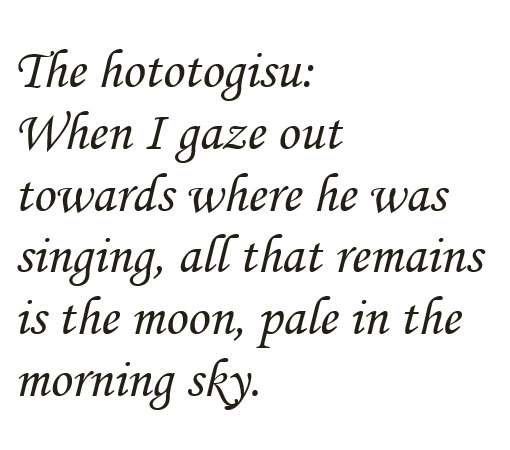
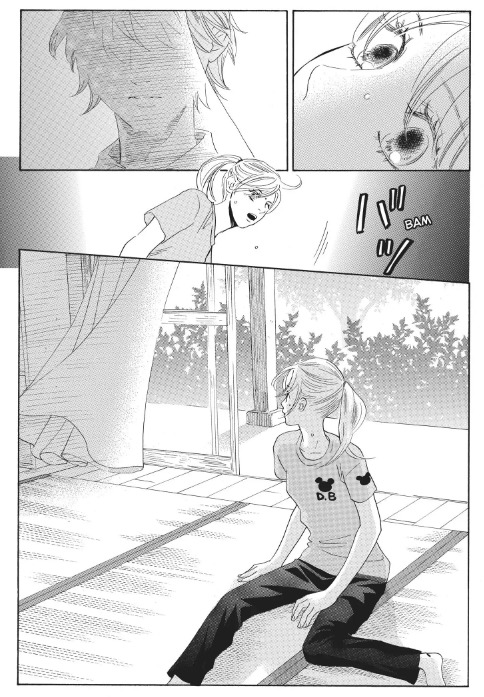
Poem 46: Yura
Yura no to wo
Wataru funa-bito
Kaji-wo tae
Yukue mo shiranu
Koi no michi kana
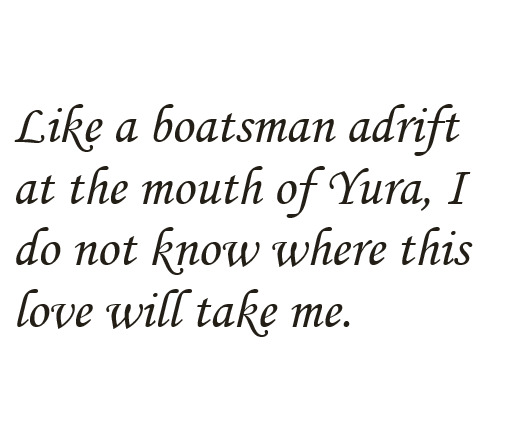
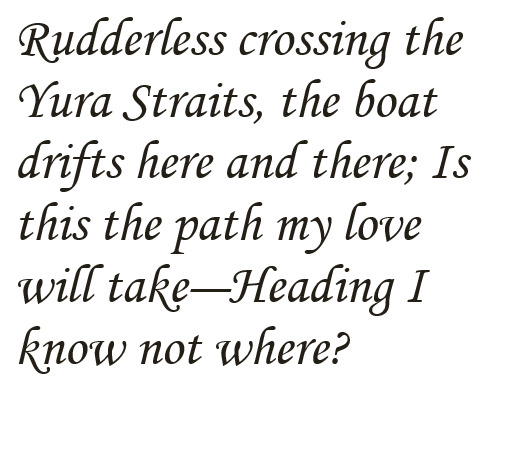
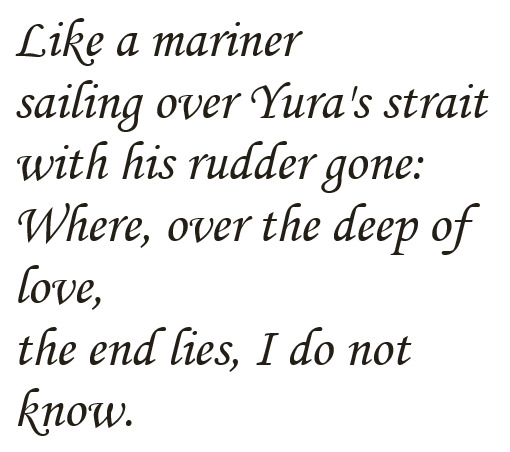

Poem 15: Kimi ga tame ha
Kimi ga tame
Haru no no ni idete
Wakana tsumu
Wa ga koromode ni
Yuki wa furitsutsu

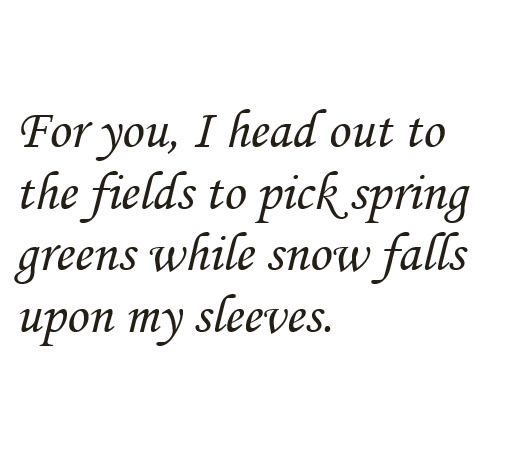
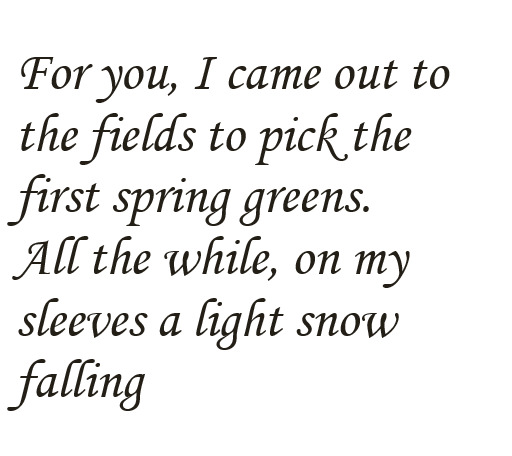

Poem 34: Tare
Tare wo ka mo
shiru hito ni sen
takasago no
matsu mo mukashi no
tomo naranakuni
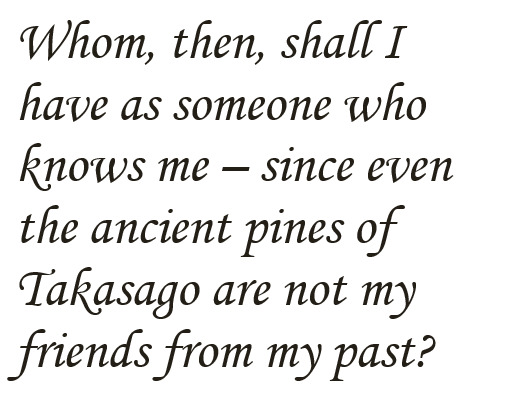
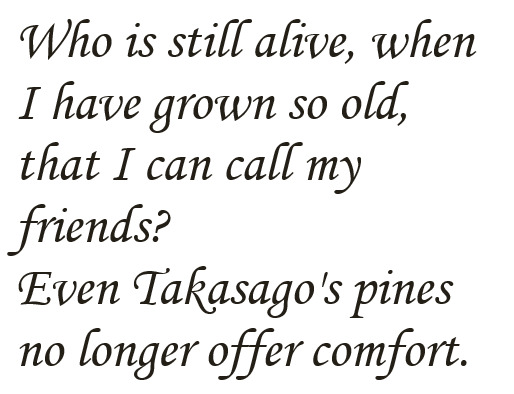


Poem 18: Su
Sumi no e no
Kishi ni yoru nami
Yoru sae ya
Yume no kayoi ji
Hito me yoku ran
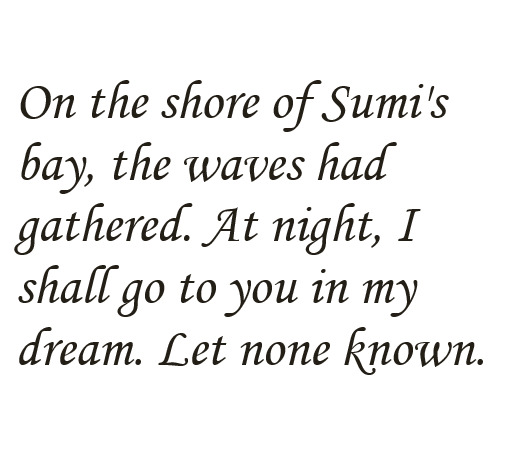

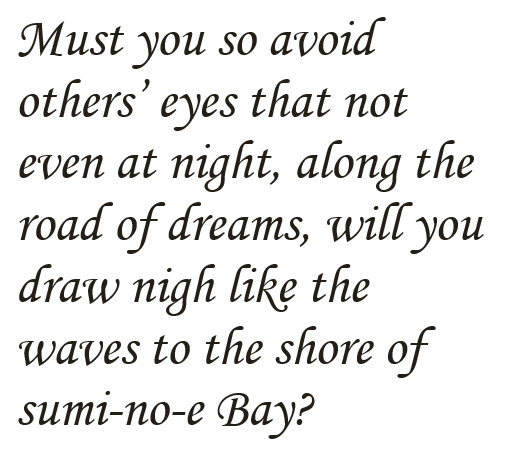

Poem 51: Kaku
Kaku to dani
Eyawa ibuki no
Sashimogusa
Sashimo shiraji na
Moyuru omoi o

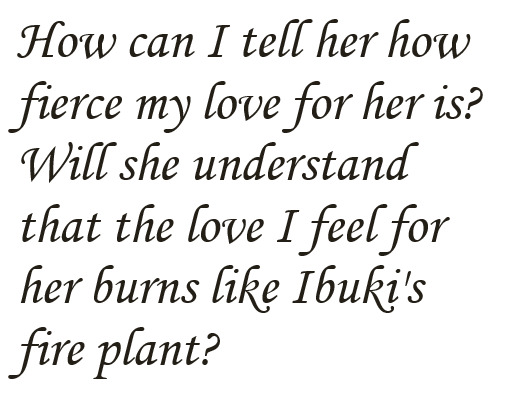


Poem 13: Tsuku
Tsukuba ne no
Mine yori otsuru
Minano-gawa
Koi zo tsumorite
Fuchi to nari nuru

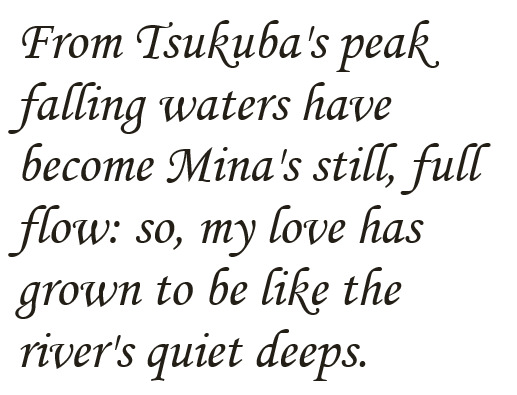
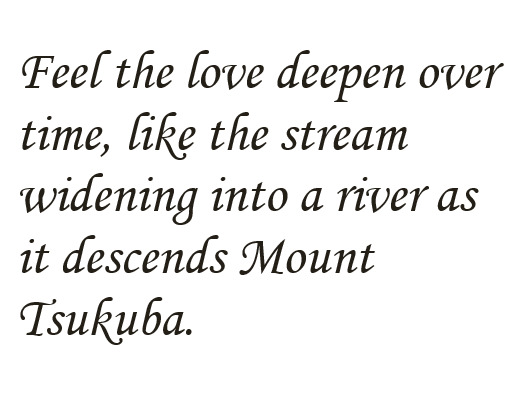
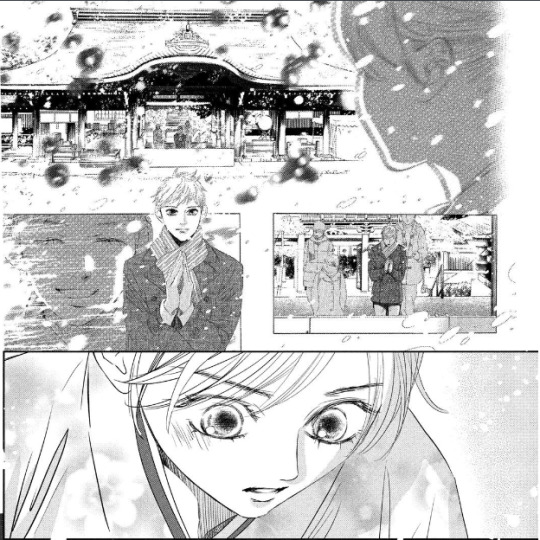
There are more poems associated with Taichihaya; we had to narrow them down to only 7. But another poem can also be used on day 7 with a "free prompt".
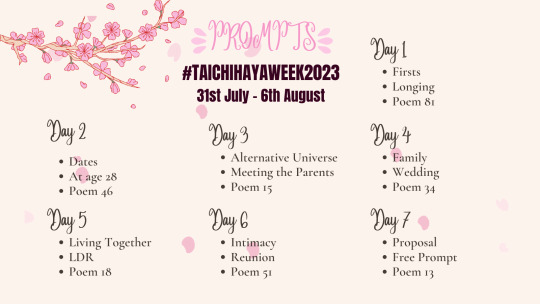
Other translations and other poems can be found here:
Also, I used some panels for each poem here. But their relation is not unique to those panels; each poem extends to way more moments and aspects of taichihaya.
49 notes
·
View notes
Text


Me when I'm famed poet Fujiwara Teika and don't approve the retired emperor's debauchery but still gotta keep him company because he's the fuckin retired emperor
6 notes
·
View notes
Text

Wabi-Sabi
- Fujiwara no Teika (1162-1241)
7 notes
·
View notes
Text
Fate Grand Order Servant Comparisons
Sei Shōnagon

Left - FGO
Right - Poem Card of the Hyakunin Isshu by Fujiwara no Teika - Edo Period
#fate grand order#fgo#sei shonagon#sei shonagon fgo#fgo sei shonagon#sei shonagon fate#fate sei shonagon
3 notes
·
View notes
Text
Beautiful but poisonous Apocynaceae Plants (Essay)

oleander

teika kazura

vinca
Sonnet of Oleander
Today I saw a young tree of oleander.
Red smart flowers,
Long and narrow leaves,
A straight branch.
Take this branch
Chopsticks
Make a barbecue skewer
There were many people
Many are killed.
There are many poisonous branches
“Beautiful things are poisonous”
Teika Kazura & Vinca
Poison with the plant of the Apocynaceae family.
Toxic plants are unexpectedly close.
(2018.07.25)
Oleander is mainly a heart poisoning and poisoning is fatal.
@@@@@@@@@@@@@@@@@
Although oleander is an excellent horticultural plant, it is strongly oral toxic, and it is necessary to be careful not to use it for cooking or eat livestock during outdoor activities. Flowers, leaves, branches, roots, and all the fruits and the surrounding soil are also toxic. The smoke that burns raw wood is also poisoned. Even for humus, it is toxic for one year, so it is necessary to pay attention to mulch.
Poisoning symptoms include nausea and vomiting (100%), limb weakness (84%), malaise (83%), diarrhea (77%), non -rotational dizziness (66%), and abdominal pain (57%). The treatment is the same as digitaris poisoning.
@@@@@@@@@@@@@@@@@@@@@@@
These are the remarkable features of oleander.
Blooming
Teika Kuzura
Demon flower
White and pretty flowers have a fragrance similar to jasmine, but it is a poisonous grass of the Apocynaceae family. As a tradition, Teika Fujiwara, who fell in love with the princess Noriko, became this plant after his death and was entangled with the grave of her. (sci:Trachelospermum asiaticum)
(2019.05.08)
Planted in a flowerbed
Grow up healthy
Vinca
(2019.07.31)
Vinca is also a plant of the Apocynaceae family, and is still poisonous.
To list various kinds of poisonous ingredients
Oleander: Orean Daron, Adyelenin, Gitoxygen, Jitoxygen
Teikakazura: Tracheloside, Lutekiolin, Apigenin (the effect is similar to Kyutou)
Vinca: Pinkuristin, pin plastic (systemic paralysis)
There are others that are suspected of being poisonous just by the name of the family,for example plants of Ranunculaceae family (such as Monkshood), the plants of the Ranunculaceae family will be lined up on the Apocynaceae.
#oleander#teika kazura#vinca#Apocynaceae family#Beautiful things are poisonous#poisonous#sonnet#haiku#poetry#essay#rei morishita
4 notes
·
View notes
Text
百人一首, poem 1: 天智天皇
So I decided to challenge myself to, over the course of my winter break from uni, analyze one poem a day from a text. (If you would like to not see these, feel free to block the #栲縄の or #takunaha-no tags.) I have gone with the 百人一首, the hyakunin’issyu, an early Kamakura-period collection of one poem from each of a hundred poets, compiled by 藤原敏行, Hudihara (Fujiwara) no Teika, a very respected and highly renowned poet of the late Heian and early Kamakura periods. The manuscript I’m working from is available from the Waseda Kotenseki database at https://www.wul.waseda.ac.jp/kotenseki/html/bunko30/bunko30_d0158/index.html.
Today’s poem, the first in the collection, is by Emperor Tendi (天智天皇).
I am transcribing from the manuscript with the following conventions: Standard kana are rendered normally; hentaigana are shown as their jibo 字母; and kanji are shown as themselves, bolded, with the reading in kana in square-brackets after it, since Tumblr doesn’t seem to like hurigana.
秋[あき]の田[多]農かり本の庵[い本]のとま越あら三
わ 可゙衣手[ころもで]盤露[つゆ]尔ぬ連つゝ
Here is it, split into the five lines of the waka, in modern standard kana:
秋[あき]の田[た]の
かりほの庵[いほ]の
とまをあらみ
わ が衣手[ころもで]は
露[つゆ]にぬれつゝ
A parse:

And a rough translation:
It is from the courseness of the woven mat of this temporary shack in the field of autumn, that my sleeve, it is getting wet from the dew*
*(also means tears)
As a note - there is a very common poetic meaning, mentioned in an earlier post of mine, of sleeves being used for crying into, further substantiating this turn of phrase between the word meaning both ‘dew’ and ‘tears.’
I probably missed a lot of meaning, but that’s what practice and learning is for! This is a reminder that I’m no expert, I am but a lowly student, and this post is probably replete with errors despite my best efforts.
2 notes
·
View notes
Text
Teika’s Handwriting!
In other recent, exciting news, I found this article on the Asahi Shimbun newspaper: the discovery of some of Fujiwara no Teika’s personal notes. This is called the kenchū mikkan (顕注密勘).
Long before Fujiwara no Teika (poem 97) compiled the Hyakunin Isshu, he served as a minister under Emperor Gotoba (poem 99). Among his duties, Teika was commissioned in 1201 to compile a new Imperial poetry…

View On WordPress
1 note
·
View note
Text
● ☾ 修井草:詩1881年
SHŪI GISŪ: 1881 POEM
この詩は、藤原正家の藤原定家(1162–1241)の個人コレクションShūi Gusō 拾遺愚草(価値のない雑草の採集)に含まれており、建暦(1211–1213)の2年(12)の12月に引退した天皇が注文した20の詩の中に、さまざまなトピックに関する5つの詩の1つとして見られます。
私の希望、–
空虚な夢のように
途中で壊れた:
たとえあなたが壊れるとしても、壊れないでください、
ああ、この苦い人生の宝石の糸。
The poem is included in Fujiwara no Teika’s 藤原定家 (1162–1241) personal collection Shūi Gusō 拾遺愚草 (Gleanings of Worthless Weeds), where it is found among the twenty poems ordered by the Retired Emperor on the twelfth month of the second year (1212) of Kenryaku 建暦 (1211–1213), as one of five poems on miscellaneous topics:
My hopes, –
like empty dreams
broken midway:
even if you are to break, do not break,
oh jeweled string of this bitter life.
思ふこと Omou koto
むなしき夢の munashiki yume no
なかぞらに nakazora ni
たゆともたゆな tayu tomo tayu na
つらき玉の緒 tsuraki tama no wo
●///////////////
🍑 桃
⊙ 卐
0 notes
Text
世上乱逆追討雖満耳不注之 紅旗征戎非吾事
世上乱逆追討、耳に満つと言へども、之を注せず。紅旗征戎、吾が事に非ず。
Schrieb Fujiwara no Teika (1162-1241) im neunten Monat des Jahres 1180 in sein Tagebuch. “Red banners and chastising rebels are no concern of mine.” ist ein Wahlspruch, dem Kenkō sicher voll und ganz zugestimmt hat. Mit den roten Bannern sind kaiserliche Banner gemeint und die Rebellen waren die Minamoto unter Yoritomo.
1 note
·
View note
Text
100 SLEEPING PRINCES & THE KINGDOM OF DREAMS

LOVE SONG NAYUTA | CHARACTER CARD #4
━
After a short rest at the tea house, Nayuta and I arrive at the venue.
Gentle winds blow through the spacious room...
NAYUTA : "Oh, this is the venue?"
Nayuta cheerfully surveys the room.
Colorful game cards are neatly lined up in front of us.
Townspeople of all ages and genders have gathered.
NAYUTA : "I'd like to do something festive for New Year. Do you have any recommendations?"
SERVER : "Would you like to watch the ongoing 'Uta-garuta’ tournament? You can even participate."
(I heard that Uta-garuta is a New Year tradition...)
I recall the words of the tea house server and look at the various cards on display.
EMMA : "This is amazing... They're as beautiful as intricate paper cutouts."
NAYUTA : "The craftsmanship is exquisite."
As I admire the various cards, a game nearby is about to start...
CHANTING PLAYER : "Morning sun..."
As the participant chants a poem, the sound of cards being flipped over fills the room.
(Impressive...)
The contestants quickly grab at the cards placed on the tatami mats.
I can't help but be captivated by the intense match...
NAYUTA : "This game is about who can pick up the card that finishes the poem the fastest."
EMMA : "Ah!"
Speaking softly to avoid disturbing the people around us, Nayuta explains.
At such a close distance, I can feel his breath on my ear, quickening my heartbeat.
Unable to read his intentions, I feel like he’s toying with me, and my heart races...
EMMA : "Nayuta, how do you know about Uta-garuta?"
NAYUTA : "I've heard about it from guests who came to soak in the hot springs."
NAYUTA : "And it always sounded so interesting, I’d be happy to play with you if you'd like?"
Nayuta smiles and his beautifully colored tail sways as if in agreement.
EMMA : "By the way, the poem you mentioned..."
NAYUTA : "Yes, the poems are written in a specific format."
He explains that people in the Country of Harmony would write poems when they were inspired by their everyday experiences or life.
Nayuta shifts his gaze from the Uta-garuta Cards to me.
NAYUTA : "And also about feelings for one's lover."
EMMA : "...!!"
He squints suggestively, and I can't quite read his emotions.
Playing with my heart as if it's in the palm of his hand, I only feel my heartbeat continuing to accelerate...
━
TRANSLATORS NOTE: Translating & finding the exact card game referenced proved difficult. Context cues have me believing the game to be the Japanese Uta-garuta:
Uta-garuta (歌ガルタ, lit. "Poetry Karuta") is a type of a deck of karuta, Japanese traditional playing cards. A set of uta-garuta contains 100 cards, with a waka poem written on each. Uta-garuta is also the name of the game in which the deck is used. The standard collection of poems used is the Hyakunin Isshu, chosen by poet Fujiwara no Teika in the Heian period, which is often also used as the name of the game.
#Otome#yume100#yume100 translations#夢王国と眠れる100人の王子様#夢100#100 sleeping princes and the kingdom of dreams#Dream Meister Translations#Nayuta
1 note
·
View note
Photo

定家葛[Teikakazura]
Trachelospermum asiaticum
定家[Teika] : 藤原定家[Fujiwara-no Sadaie|Teika], the compiler of the Ogura Hyakunin Isshu.
葛[Kazura] : Creeping plant
Asiatic jasmine. It is a creeping plant and poisonous. The flowers have a sweet fragrance. The name comes from the name of a vine in the Noh play "Teika."
https://www.the-noh.com/en/plays/data/program_117.html
https://en.wikipedia.org/wiki/Princess_Shikishi
17 notes
·
View notes
